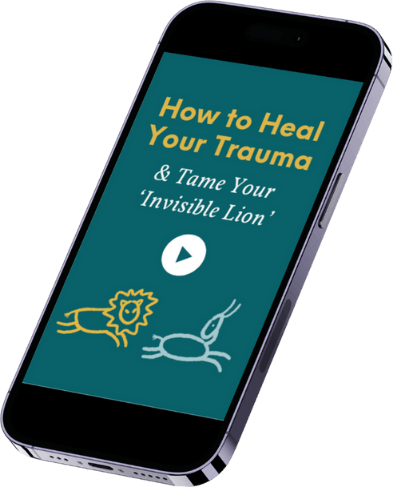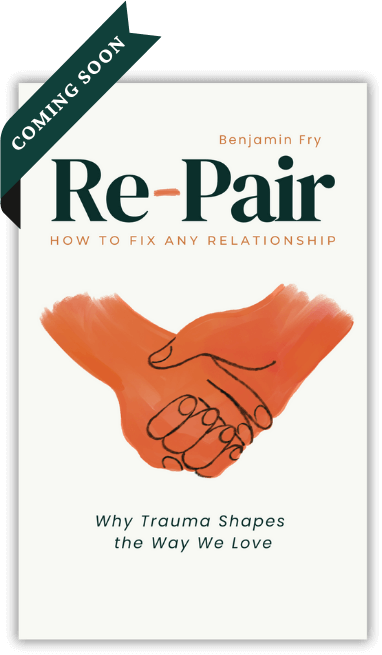In freeing ourselves from a dysregulated nervous system, an important step is learning how to reframe our experiences. We need to do this so that we are no longer subject to learned ways of behaviour that negatively impact our lives and the relationships we have with others.
The goal is to go from the diagram on the left below to the one on the right.

In the diagram on the left, in which our baggage is represented by the red squiggle, triggers are the green arrow, and our reaction is the red arrow, you can see a dysregulated nervous system – one that overreacts to the trigger. The diagram on the right represents a nervous system that is well regulated as a result of using boundaries and containment.
To reframe our experiences, we must bring attention to our triggers, our baggage, and our reactions. It’s easy to consider ourselves the victim in situations that trigger us and make us feel unsafe, but there is very little we can do to control what life throws at us. What we can do, however, is use boundaries and containment to lessen the impact that our triggers have on our baggage. When we do this, we create something like a shield around that vulnerable, wounded part of ourselves.
For the purposes of this blog, let’s look at how we can approach our baggage and reframe how we experience it.
Let’s look at the example of Eric in the office to see how this can be applied in practice.
You work in an open plan office and you are on a tight deadline for an important project. Eric sits opposite you and often tries to engage you in conversation. You are quite shy but don’t want to just say outright that you don’t want to talk. You feel trapped and the stress of your deadline just keeps growing.
In dealing with you triggers and reactions, you could be open and honest with Eric by saying something like:
‘Hey Eric, I’m on a deadline and the conflict of also wanting to talk to you is a trigger for me. I notice that it makes me stressed and I’d like to avoid that.’
Or you could keep your reaction work related by saying:
‘It makes me less productive because I feel like I’m in two places at once.’
In doing so, you act as a witness to yourself. The goal of working with our reactions is to notice them in the simplest way possible. We want to avoid blame and judgement..
To set up this process of drawing the other person in, rather than putting them on the defensive, you start with the careful explanation of the trigger. If you don’t attack, blame or judge with the trigger, you will usually find that the person you are talking to (even if it is yourself) can also find some degree of empathy and compassion with whatever the difficult experience, sensations or feelings you are having in reaction to this trigger.
All of this then sets the stage for the final part of opening up the window into your nervous system, which is when, in the image above, we go from the diagram on the left to the one on the right.
In the diagram on the left, in which our baggage is represented by the red squiggle, triggers are the green arrow, and our reaction is the red arrow, you can see a dysregulated nervous system – one that overreacts to the trigger. The diagram on the right represents a nervous system that is well regulated as a result of using boundaries and containment.
By not alienating or abusing the other person, and by even generating some empathy for our experience, we are creating the right conditions safely to explore and expose our baggage. We now get to tell them why we had the reaction we did. Or, at least, have a really good guess.
Our baggage, of course, is at the heart of all of our problems. It is the unfinished business from our responses to threat in the past. In nervous system recovery terms, it’s our greatest opportunity but also our greatest threat. Revisiting unfinished threat responses is always going to be difficult because we are returning to the experiences which most overwhelmed us in the past, but completing them is our surest pathway back to regulation. All the same, it’s something to approach very carefully.
Once you have carefully identified your trigger, and diligently noticed and safely articulated your reaction, it’s time to open up the bit in the middle, the bit that links the trigger to that reaction.
This is where we start to guess at the origin of our baggage.
It is a fairly simple formula. Once you’ve described the trigger and the reaction that went with it, you try to make sense of the distance between the two by telling yourself, or the other person, what this combination of your trigger and your reaction reminds you of. It might not work; it might not remind you of anything. But usually, especially if you have got the first two parts right, you will find that the baggage comes into view.
So, in our example in the office setting, dealing with our baggage might look something like this:
“Hey Eric, I’m on a deadline and so the conflict of wanting to talk to you is a trigger for me. It makes me less productive because I feel like I’m in two places at once.”
And then you might add:
“I felt like that in my last job and it didn’t work out so well. So I’m trying to do something differently here.”
What this brief snippet of conversation does is opens up a window into the link between your nervous system, your behaviour and, therefore, your relationships. It puts this picture into language that’s specific to that situation.
And it keeps you in relationships while you do it. Staying connected is the very best thing you can do for your nervous system. It regulates you and gives you a chance to repair attachments. To be able to process unfinished business whilst staying connected is priceless.
I could give you a thousand examples, but this only works if you practice it for yourself in situations that are meaningful to you.
You can download this post in a handy 2-page PDF to print and share with friends, family, clients or colleagues. Follow this link to download now.
You can buy a copy of The Invisible Lion now on kindle or paperback from your local Amazon store. Just click here to buy now.






